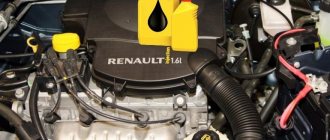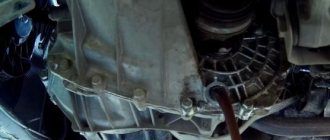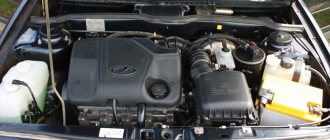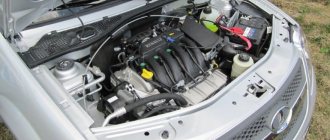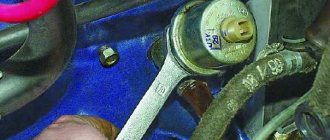1200 rub. for the photo report
We pay for photo reports on car repairs. Earnings from 10,000 rubles/month.
Write:
Changing the oil in the Lada Largus engine is a common procedure for periodic vehicle maintenance, which is performed approximately every 15 thousand km. mileage (some drivers change it to 10). Any man can change the engine oil with his own hands—there’s nothing complicated about it.
Changing the oil in a Lada Largus (16 valves) involves removing the crankcase protection. Otherwise, you won’t be able to get to the oil filter, which also needs to be replaced. After removing the protection, you need to place a container for used oil, unscrew the drain plug, and drain the oil.
While he's running away, you can work on the oil filter. To remove it, you will need a puller . There are several types of oil filter pullers, but in this case the so-called “crab” is most suitable.
This video with instructions will allow you to see how to change the oil and oil filter on a Lada Largus.
The choice of oil for internal combustion engines should be given special attention, since the operation of your vehicle depends on its quality. Therefore, you need not only to replace it on time, but also to know what consumables to fill. Now you can find out which engine oil is suitable for Lada Largus and how to change it.
We change the oil ourselves
There is nothing scary about this process - even a person who has never driven a car can handle it. If you follow the steps and tips described in this material, you will be able to do everything correctly and your “iron horse” will be very grateful to you.
Which oil is suitable?
The choice of motor oil (hereinafter referred to as MM) for replacement in the 16 valve Lada Largus engine is the first difficulty faced by a car owner who decides to replace this consumable. We need to dwell on this point in more detail, since many Lada owners often make mistakes when choosing motor fluid.
Car Lada Largus
As mentioned above, the quality of this consumable material affects the operation of the engine, as well as the wear resistance of the elements of the internal combustion engine system. If the filled engine oil is of low quality or does not meet the vehicle manufacturer’s recommendations, then the service life of the machine is significantly reduced. In addition, if your car is relatively new and is under warranty, then if you operate a low-quality MM, you may simply be denied engine repair if necessary.
To find out exactly what consumables should be filled into the Lada Largus, you should read the service manual for your car. The necessary parameters and characteristics that the motor fluid must have are clearly indicated there.
In particular, for a 16-valve Largus engine, the manufacturer recommends using a MM that meets the following quality classes:
Oil filter replacement intervals
According to the technical regulations and recommendations of the manufacturer, the frequency of replacing the oil filter on the Lada Largus is 15 thousand km . Under severe operating conditions, this figure is reduced to 10 thousand km.
The oil filter in a car is changed along with the lubricant usually once a year. A new filter element is purchased in accordance with the manufacturers' recommendations from official dealers. The article number of the required consumable can be found in the technical documentation; for these car models buy Renault 7700274177.
If analogs are purchased from other manufacturers, pay attention to the availability of quality certificates and compliance with GOST. It is recommended to purchase consumables only from official dealers and trusted suppliers.
How to drain engine oil
You will need : buy engine oil and an oil filter, prepare a “10” wrench, an “8” square wrench, a clean cloth, an empty 5 liter container. and a wire brush.
The engine oil should be drained after a trip while the engine is still warm (if necessary, warm it up to operating temperature). It is recommended to drive the car onto an overpass.
Procedure:
- Unscrew the oil filler plug.
- (At the bottom of the car on the engine crankcase), clean the drain plug with a wire brush, then unscrew it. Be careful not to burn yourself!
- After all the oil has run out (about 10 minutes) into a previously placed container, clean the plug from dirt and screw it back.
Under the plug there is a steel washer on the surface of which a thin layer of rubber is vulcanized. If it is damaged, replace the washer with a new one. If you do not have a new washer, you can install a copper washer with a hole diameter of 18 mm under the plug.
2271-3-8-02-01
From the bottom of the car, using a “10” tool head, unscrew the six bolts securing the power unit protection and remove the protection.
From the bottom of the car, using a “10” tool head, unscrew the six bolts securing the power unit protection and remove the protection.
From the bottom of the car, using a “10” tool head, unscrew the six bolts securing the power unit protection and remove the protection.
How to fill engine oil
We pour new oil into the engine through the oil filler neck, the amount of oil in the engine is indicated in the table above. (about 0.3 liters of oil will still remain in the engine). We control the level using the oil dipstick (the oil level should be between the MIN and MAX marks).
Start the engine and let it idle for a few minutes. The emergency oil pressure indicator should go out 2-3 seconds after starting the engine. While the engine is running, check for oil leaks from under the drain plug and oil filter. Stop the engine and check the oil level; if necessary, add oil to the specified level.
The entire process of changing the Lada Largus oil is also shown in the video:
All steps for changing oil on Largus “step by step”
Let's consider what to do before changing the oil in the Lada Largus engine if the number of valves is 16:
- Warm up the engine, turn off the ignition, drive the car into the pit;
- Remove the crankcase protection. You need a 10mm socket wrench - use it to unscrew the six screws from the bottom;
Fastening the crankcase protection
The protection is removed for one purpose - to get to the filter.
Draining waste (old engine oil)
There is no crankcase protection now. All that remains is to take the 8-sided socket and unscrew the drain plug.
Drain hole for plug
Make 1-2 turns with the key, then place an empty container and unscrew the cap by hand.
The time for draining used oil is at least 10 minutes. Be careful, the oil is hot!
After the waste has drained, the surface of the crankcase is wiped and the plug is wrapped. Thread tightening torque – 22 N*m.
Replacing the oil filter
It would seem that the old material has been drained and now is the time to complete the replacement. But you still need to change the oil filter.
Filter housing - put a puller on it
It is easier to access the filter housing from below. We take the puller and unscrew the filter by rotating the housing counterclockwise.
100-200 ml of waste will flow out of the old filter.
The new filter housing must be filled with oil, but not completely, but by a third. You will need 70-100 ml of material. The rubber seal is lubricated with the same oil.
Preparing the filter for installation
After wiping the engine crankcase, screw in the new filter until it stops. The tightening torque will be 15-17 N*m (by hand).
Pour in new oil
The oil volume in the Lada Largus engine, if the timing belt contains 16 valves, is 5 liters. You need to fill 4.8 liters through the neck. Then close the plug and start the engine.
The indicator light is now on
The point is to turn off the oil pressure light. We start, wait three minutes and turn off the engine.
Even if the control lamp did not light up, wait 5-6 minutes and check the level. The check is carried out using a dipstick, and you can find it near the power steering reservoir.
Read more: Spotlight how to change a light bulb
Oil level dipstick
We remove the dipstick and look at the marks. If necessary, add oil. The main thing is to return the dipstick to its place, pressing it all the way.
The filler neck can also be used to pump out oil. Thin tubes and a bulb will help solve the problem.
Signs of a clogged oil filter
The main purpose of the oil filter is to clean the circulating oil from impurities. They arise during the production of lubricating fluid, friction of mechanisms, and temperature changes.
A pressing issue for many car owners is identifying signs of the need for replacement . These usually include:
- extraneous sounds in engine operation, twitching, vibration;
- reduction in engine power, activation of the emergency light;
- change in lubricant color, appearance of sediment, burnt odor.
However, experts do not recommend waiting for such factors to manifest themselves. These signs already indicate malfunctions in the system and increased wear of parts. To prevent costly repairs, attention is paid to preventive measures and timely replacement of the lubricant and oil filter.
Read more: How to connect speakers from a computer to a car
Regarding the operation of the filter itself, its throughput is emphasized. When worn, it decreases, which limits the supply of lubricant to the operating mechanisms of the engine.
Many car owners, instead of completely replacing the oil filter, clean it and return it to its place. This option is allowed as a temporary measure, however, for a long-term effect, the filter element must be changed along with the oil.
Largus gearbox oil partial and complete replacement
Approach to the Lada Largus engine
Let's start with the fact that the manufacturer indicates in the manual that there is no need to change the oil in the Lada Largus gearbox, that is, the gearbox is considered maintenance-free. In other words, it is filled with lubricant for the entire service life of the vehicle, and changing the transmission oil may only be necessary if the gearbox is repaired.
In practice, the situation is somewhat different, since any lubricants have their own service life. In parallel with this, gearbox wear products accumulate in the oil. This means that the oil in a fully functional gearbox needs to be changed earlier to protect the unit from wear.
Taking into account the recommendations of specialists and experienced car enthusiasts, it is optimal to replace every 60-80 thousand km. If the car is constantly used in difficult conditions, then changing the oil in the gearbox may be necessary after 50 thousand km. mileage
So, on the Lada Largus, Elf 75W80 Tranself TRJ oil is poured into the gearbox from the factory. As for the level and condition of the transmission oil, it is optimal to perform checks every 15-20 thousand km. In this case, in the case of topping up, you need to use only the oil that is already poured into the gearbox.
This means that even if a lubricant with similar properties was selected, an undesirable reaction may occur between the additive packages, which will lead to a significant deterioration or loss of useful properties of the entire volume of lubricant.
If a complete replacement is performed, the old lubricant must first be drained, after which transmission oil is poured in, which meets all manufacturer’s tolerances.
Let's move on to checking the oil level in the Lada Largus gearbox and adding lubricant to the gearbox if necessary. To check the level and add oil to the box, you need to prepare: a syringe, a container, a wrench with a square head of 8, suitable oil.
The necessary syringe can be purchased at an auto parts store. At the same time, the kit includes a rubber hose that allows you to reach the filler holes.
- To check the level, first you need to remove the engine protection, after which you need to unscrew the gearbox filler plug with a key. In this case, before unscrewing the plug, you should place a container so that the oil does not spill on the floor.
- Normally, the oil level in the gearbox should be slightly below the edge of the filler hole. If there is not enough oil, it needs to be added. To do this, you need to insert a syringe filled with lubricant into the filler neck.
- The liquid is added until it begins to flow out through the control hole. In this case, you need to wait until the oil stops leaking. Only after this can you tighten the plug, after wiping the place where it is installed with a clean rag.
- Let's also add that there is an O-ring on the plug. If its condition or integrity is in doubt, then it is better to replace such a ring immediately. Otherwise, oil may leak from under the plug.
If there is a need to completely change the oil in the Largus gearbox, the procedure will require similar tools and actions as with regular topping up. In terms of filling volume, about 3 liters of gear oil will be required.
It is also advisable to keep a small reserve, since there is a possibility that during further operation it may be necessary to add oil to the box.
Please note that the box can fit less than 3L. oil, since certain residues of old lubricant remain in the cavities of the box
You should also pour fresh oil into the filler hole slowly and gradually.
Once lubricant begins to flow out of the inspection hole, we can assume that the box is completely filled with transmission fluid. In this case, you need to tighten the plug, after which it is advisable to start the internal combustion engine and at idle speed with the clutch depressed, you should engage different gears of the manual transmission.
This will allow the oil to be distributed throughout the gearbox. In some cases, after this procedure, the engine is turned off, after which the lubricant level in the gearbox is checked again.
Where is the oil filter located?
The oil filter in the Lada Largus is located next to the crankcase and the drain plug. It is easy to recognize by its cylindrical case, which is predominantly blue. It can be unscrewed by hand, but if it is tightened too tightly, additional tools may be required.
In some assemblies, the location of the filter element may vary. To obtain the necessary information, refer to the technical documentation or find the oil filter yourself. Also, for easy access to it, additional steps may be required to dismantle the pipes and units.
Preparation for replacement and necessary tools
The process of preparing to replace the Largus oil filter includes three main points:
- purchase of new parts and consumables;
- parking the car on level ground;
- warming up the engine to operating temperature if it has not been running for a long time.
For convenience, it is recommended to use an overpass, inspection hole or lift. In the absence of the appropriate opportunity, the car is raised using a jack and supports.
When working with oil, pay attention to safety precautions . The main emphasis is on its high temperature and toxicity. To avoid thermal and chemical burns, the entire procedure should be performed with rubber gloves and overalls.
The list of tools for replacing the oil filter in Lada Largus consists of the following equipment :
- a set of keys and screwdrivers, a collar with attachments, a probe, pliers;
- clean, lint-free rags or rags, rubber gloves;
- container for draining used lubricant;
- new oil, funnel for filling;
- new oil filter, seals and gaskets, and other components to replace worn parts.
During the preparation process, it is also recommended to check the system for worn connections, which can soon lead to breakdowns and leaks. Preventative replacement of parts allows you to avoid costly repairs and unforeseen complications.
Step-by-step replacement instructions
The sequence of replacing the oil filter for Lada Largus implies the following procedure:
- in the engine compartment, uncork the filler neck;
- dismantle the lower engine protection;
- Place a container under the drain in the lower part of the crankcase and unscrew the plug;
- the heated lubricating fluid usually drains within 10-15 minutes;
- during this time, clean the plug, change the washer if necessary;
- They also place a container for used lubricant under the oil filter and unscrew it;
- remove the cartridge, make sure that the perforated tube remains in place, clean the internal cavity of the casing dry;
- the rubber seals of the new filter element are lubricated with oil, some also wash the filter itself;
- Next, the filter element is mounted in place, while tightening, monitor the position of the sealing rubber bands - if they come out of the grooves, a leak will soon appear;
- tighten the drain plug, return the system to its original form;
- New lubricant is poured into the filler neck.
Read more: A ps 2700
Based on the volume of oil poured, they are guided by the amount that was drained. Some experts recommend immediately filling it to the maximum, arguing that as the engine warms up, the oil will disperse throughout the system.
After filling, start the engine and let it run for 10-15 minutes. At first, the emergency light may come on, indicating a lack of oil in the system.
After warming up, measure the lubricant level - in the heated state, its amount should not exceed the upper permissible limit on the dipstick. If necessary, the excess is pumped out with a syringe or bulb.
It is also recommended to measure the oil level when the engine has cooled down - the volume should not be below the permissible minimum. After the first trips, it is recommended to check the system and oil filter for leaks.
In accordance with the maintenance regulations, the oil in the 16-valve Lada Largus engine, as well as the oil filter, should be changed every 15 thousand kilometers. The step-by-step instructions with photos below will help you cope with this task.
LADA > Largus
We carry out the work of changing the oil and oil filter in the 16-valve Lada Largus engine on an inspection ditch or overpass.
We carry out the replacement with the warm engine not running, preferably immediately after the trip, before the oil has cooled down.
Remove the oil filler cap.
